PRINCETON, NJ -- Political ideology in the U.S. held steady in 2011, with 40% of Americans continuing to describe their views as conservative, 35% as moderate, and 21% as liberal. This marks the third straight year that conservatives have outnumbered moderates, after more than a decade in which moderates mainly tied or outnumbered conservatives.
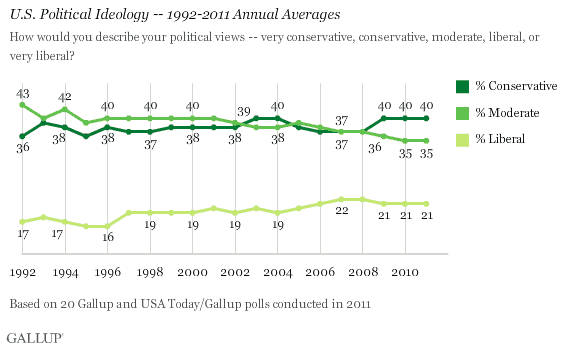
The percentage of Americans calling themselves "moderate" has gradually diminished in the U.S. since it was 43% in 1992. That is the year Gallup started routinely measuring ideology with the current question. It fell to 39% in 2002 and has been 35% since 2010. At the same time, the country became more politically polarized, with the percentages of Americans calling themselves either "conservative" or "liberal" each increasing.
Gallup measures political ideology by asking Americans to say whether their political views are very conservative, conservative, moderate, liberal, or very liberal. Relatively few Americans identify with either extreme on this scale, although 2 in 10 Republicans self-identify as very conservative -- double the proportion of Democrats calling themselves very liberal.
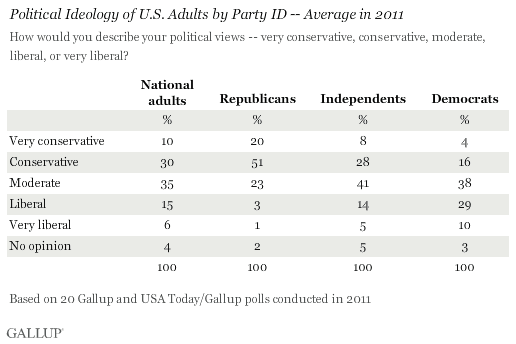
The 2011 results are based on 20 Gallup and USA Today/Gallup surveys conducted between January and December, encompassing interviews with 20,392 U.S. adults, including 5,912 Republicans, 6,087 Democrats, and 8,064 independents. The trends represent annual averages of multiday Gallup surveys conducted each year.
Conservatives Dominant Among Republicans
The majority of Republicans say they are either very conservative or conservative, but the total proportion of conservatives grew 10 percentage points between 2002 and 2010, from 62% to 72%. At the same time, the percentage of moderates fell from 31% to 23%. Relatively few Republicans say they are liberal -- just 4% in 2011. Republicans' ideology largely held at the 2010 levels in 2011.
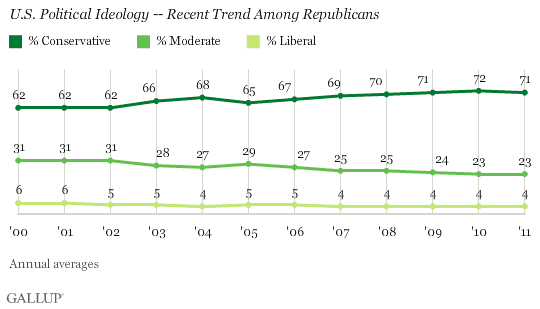
Democrats Maintain Moderate-Liberal Divide
As recently as 2002, the solid plurality of Democrats were "moderate," while smaller, but nearly equal, percentages called themselves "liberal" and "conservative." From 2003 through 2007, the liberal share of the party grew to 38%, while the "moderate" and "conservative" percentages each diminished somewhat.
As a result, from 2007 through 2011, the party has consisted of equal percentages of moderates and liberals, at about 38% to 40%, while about 20% have called themselves conservative.
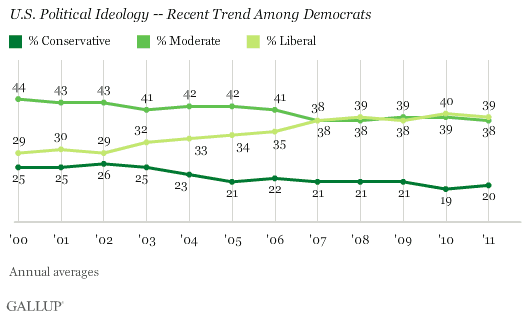
Independents Mostly Moderate, but Also More Conservative Than Liberal
Independents -- who make up the largest political group in the country -- have been steadier ideologically than either major party group over the last decade. However, since 2008, the proportion describing themselves as moderate has declined slightly, from 46% to 41%, and the proportion who are conservative has increased slightly, from 30% to 35%.
Currently, the largest segment of independents describe their views as moderate, while significantly more identify as conservative than as liberal, 35% vs. 20%.

Young Americans Are More Moderate; Older Americans, More Conservative
The ideological profile of adults aged 18 to 29 is markedly different from that of Americans in all older age groups. The plurality of young adults, 40%, are moderate, while equal percentages -- 28% -- are conservative or liberal. By contrast, the plurality of all older age groups, 40% or more, are conservative, while about a third are moderate and no more than 21% liberal.

Notably, the upward trend in conservatism among all Americans since 2002 is seen primarily among adults 30 and older. While those 18 to 29 grew more conservative for a brief period from 2002 through 2005, the percentage conservative subsequently reverted to fewer than 3 in 10, while conservatism continued to edge higher among older Americans.

Given that the adults aged 18 to 29 in 2000 make up the majority of 30- to 49-year-olds in 2011, it appears that conservative views take hold as Americans age, which may also explain the even higher rates of conservatism among 50- to 64-year-olds and seniors. However, in addition to these age patterns, it appears that conservatism has increased overall since 2002 because of heightened conservatism among all age groups of Americans 30 and older.
The percentage "liberal" rose slightly among all age groups over the past decade, although spikes in liberalism among certain groups in 2007 and 2008 did not last.
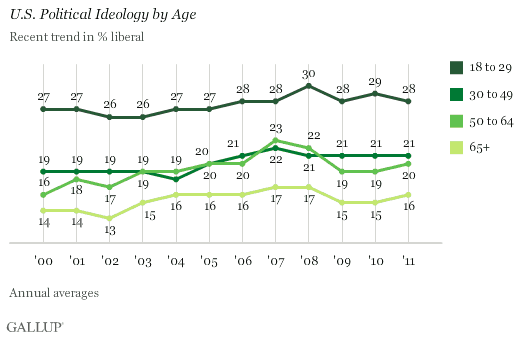
Bottom Line
Sizable segments of Americans identify with each of the three major ideological groups on the U.S. political spectrum; however, in recent years, conservatives have become the single largest group, consistently outnumbering moderates since 2009 and outnumbering liberals by 2-to-1.
Overall, the nation has grown more ideologically polarized over the past decade, with the percentage of moderates declining from 40% to 35% and the percentages of conservatives and liberals each rising. The increase in the proportion of conservatives is entirely the result of increased conservatism among Republicans and independents, and is also seen in Americans 30 and older -- particularly seniors. The increase in the proportion of liberals is seen exclusively among Democrats as well as in all age groups.
At the same time these shifts have occurred, Americans' party affiliation has tended to skew more Democratic than Republican, although in 2010 and 2011, the parties were about equal when the leanings of independents are taken into account.
Survey Methods
2011 results are based on the combined data for 20 separate Gallup and USA Today/Gallup polls conducted from January through December 2011.
For results based on the total sample of 20,392 national adults, one can say with 95% confidence that the maximum margin of sampling error is ±1 percentage point.
Party breakdowns for this 2011 report are based on 5,912 Republicans, 8,064 independents, and 6,087 Democrats. For results based on samples of these sizes, one can say with 95% confidence that the maximum margin of sampling error is ±2 percentage points.
Interviews are conducted with respondents on landline telephones and cellular phones, with interviews conducted in Spanish for respondents who are primarily Spanish-speaking. Each sample includes a minimum quota of 400 cell phone respondents and 600 landline respondents per 1,000 national adults, with additional minimum quotas among landline respondents by region. Landline telephone numbers are chosen at random among listed telephone numbers. Cell phone numbers are selected using random-digit-dial methods. Landline respondents are chosen at random within each household on the basis of which member had the most recent birthday.
Samples are weighted by gender, age, race, Hispanic ethnicity, education, region, adults in the household, and phone status (cell phone only/landline only/both, cell phone mostly, and having an unlisted landline number). Demographic weighting targets are based on the March 2011 Current Population Survey figures for the aged 18 and older non-institutionalized population living in U.S. telephone households. All reported margins of sampling error include the computed design effects for weighting and sample design.
In addition to sampling error, question wording and practical difficulties in conducting surveys can introduce error or bias into the findings of public opinion polls.
For more details on Gallup's polling methodology, visit www.gallup.com.
